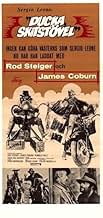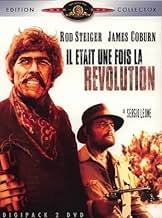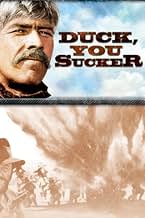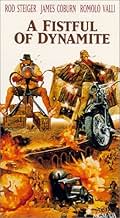IMDb रेटिंग
7.6/10
39 हज़ार
आपकी रेटिंग
एक कम जीवन डाकू और एक आईआरए। विस्फोटक विशेषज्ञ सरकार के खिलाफ विद्रोह करते हैं और मैक्सिकन क्रांति के नायक बन जाते हैं।एक कम जीवन डाकू और एक आईआरए। विस्फोटक विशेषज्ञ सरकार के खिलाफ विद्रोह करते हैं और मैक्सिकन क्रांति के नायक बन जाते हैं।एक कम जीवन डाकू और एक आईआरए। विस्फोटक विशेषज्ञ सरकार के खिलाफ विद्रोह करते हैं और मैक्सिकन क्रांति के नायक बन जाते हैं।
- पुरस्कार
- 1 जीत और कुल 2 नामांकन
Rik Battaglia
- Santerna
- (as Rick Battaglia)
Antoine Saint-John
- Gutierez
- (Italian, English version)
- (as Domingo Antoine, Jean Michel Antoine)
- …
कहानी
क्या आपको पता है
- ट्रिवियाSergio Leone offered the role of Juan Miranda to Eli Wallach, but Wallach had already committed to another project. After Leone begged Wallach to play the part, he dropped out of the other project and told Leone he'd do his movie. However, the studio already had Rod Steiger signed. Leone offered no compensation to Wallach, and Wallach subsequently sued.
- गूफ़In the train, the automatic pistol that Juan Miranda uses is a Browning GP35. As its names suggests, this model became available in 1935 (so a contemporary of the aforementioned MG42).
- भाव
John H. Mallory: [to Dr. Villega] When I started using dynamite... I believed in... many things, all of it! Now, I believe only in dynamite. I don't judge you, Villega. I did that only... once in my life. Get shovellin'.
- क्रेज़ी क्रेडिटA quote from Chairman Mao regarding the nature of revolutions was removed from original English prints out of fear that audiences would misinterpret the quote's use as an endorsement of communist revolution. The quote was later put back into uncut prints.
- इसके अलावा अन्य वर्जनThe new 5.1 remix of the soundtrack on the restored Region 2 Special Edition release uses incorrect music cues for several scenes including the restored long flashback scene at the end, and edits out two expletives, one is uttered by Juan while talking to himself before attacking the bridge, the other spoken by John on the train. Both of these are intact in all other restored versions. The title of the restored version is now "Duck You Sucker" while the title on the cover remains "A Fistful of Dynamite".
- कनेक्शनEdited into Spaghetti Western Trailer Show (2007)
फीचर्ड रिव्यू
With Fistful of Dyanmite (a.k.a. 'Duck, You Sucker', a.k.a. 'Once Upon a Time in the Revolution', the second part of a 'trilogy'), legendary Sergio Leone puts together something experimental, even more so than the other films in his catalog. Here he now deals with war, but he still has the crime elements of his 'dollars' films; it somehow makes a very clear cut balance between bits of comedy within the tragedy worked in the story; it isn't very brutal, but it is graphic in the genre sense of the time. It's also one of his best films, if you happen to see it within its full running time (like most of Leone's films, this suffered drastic cuts in American versions, reducing critical character points and other Leone surprises).
A Leone film, however, can only be as strong as the leads pushing it up, as in the dozens and dozens of westerns and other films that inspired Leone. Here he uses two character actors (for the most part of their careers), but indeed very good and astute ones at playing their parts. Rod Steiger, who has been in classic films like On the Waterfront and The Pawnbroker, here is slightly like a maturer version of Tuco from The Good, the Bad, and the Ugly: he's still a bandit, with pillaging and beating and raping his way across the countryside, but he's also got a family to look after, who within his anti-hero heart are the most important things to him. Steiger's Juan is usually either surprised, quietly delighted, or agitated off to certain degrees. He plays this for all it's worth, but he also finds the best notes in the moments when he brings out laughs, and in the more sorrowful moments later on in the film.
There's also James Coburn, veteran of many, many films, given one of the great themes of any character in a Leone film by composer Ennio Morricone (there's some sort of instrument or distortion of one in his theme that calls for complete, unusual attention on the viewer). Coburn's Sean (err, John, depending) is a character with some ghosts, perhaps, in his past, and who unlike Juan is more interested in 'other' interests. Although Juan tries not to notice it until the sequence at Mesa Verde (which I won't reveal), Sean has been through a revolution in Ireland, and understand more or less what happens with it. He brings in Juan, after a rather strange yet hilarious encounter, into his web of revolutionary fighters, which doesn't go over to well with him at first. As their story unravels, Coburn still plays it like a pro, being the straight character to Steiger's very theatrical-like performance. He doesn't quite have the mystery an Eastwood or Bronson had in the other Leone films, but he does carry a certain quality about him that puts him in a needed place in the Leone cannon.
Speaking of which, one must not over-look how complex a film like this is in some ways. Leone was not originally the director (it went through the hands of Peter Bogdanovich and Sam Peckinpah before coming to him, coincidentally the opening scene with Juan is a cool homage to the Wild Bunch opening). Yet somehow he puts his stamp, and wonderful mark, on Fistful of Dynamite. This time more history is worked into the film- unlike the civil war acting like a harsh backdrop to the more 'fun' elements of the adventure in The Good, the Bad, and the Ugly, the war in this film affects the main character, and adds a serious tone to an otherwise standard genre picture.
The Steiger character, along with the audience, gets a look at a massive amount of death, or rather the images of the dead: a tower filled with soldiers blown at night, the powerful pans and camera moves across the bodies, real combat, and the suggestions of what goes into the revolution. But its not just the violence of battles that get into the film, its also the personal attitudes during the revolution- the bourgeois vs the peasants (one of Leone's masterstrokes at close-ups in montage is displayed when Juan is on the train with the near monstrous American wealthy early in the film). Leone manages to work in various and cinematic explosions, in-depth or testing close-ups, and sweeping long shots of soldiers, landscapes, and struggle.
Coming back to Ennio Morricone's score- this time, Morricone experiments with some styles of his talents. As when Leone uses a funny, almost cartoon-like, image above Sean from Juans' eyes of a 'Banco' sign (akin the a 'dollar' sign above cartoon characters), Morricone adds a church organ and choir to go along with it. There are also the uses of themes throughout the film, as in Leone's other films, that act like striking, beautiful calling cards. The opening theme is pounding; Sean's flashbacks are given the sumptuous qualities that go with the best (and worst) nostalgia; the scenes with action and suspense, though almost a little standard, still work far better than many standard score of today.
Fistful of Dynamite is entertainment on an epic scale, with a broader and somewhat deeper sub-text, and it comes out with flying colors. Some may not take to it; it could be argued that Steiger, much like Eli Wallach, isn't very convincing as a Mexican bandit, or that the shifting in tones is a little much, even conventional in a weird sense. But it's hard to argue the sense of control that Leone has over his environment in the film, the assuredness of style, and that at the least the parts are greater than the whole. For me, it's a film I've seen twice in one week (once to soak in and get more of the enjoyment, the second time to get even more out of it, and to notice the visual details), and I hope it gets better the next time around.
A Leone film, however, can only be as strong as the leads pushing it up, as in the dozens and dozens of westerns and other films that inspired Leone. Here he uses two character actors (for the most part of their careers), but indeed very good and astute ones at playing their parts. Rod Steiger, who has been in classic films like On the Waterfront and The Pawnbroker, here is slightly like a maturer version of Tuco from The Good, the Bad, and the Ugly: he's still a bandit, with pillaging and beating and raping his way across the countryside, but he's also got a family to look after, who within his anti-hero heart are the most important things to him. Steiger's Juan is usually either surprised, quietly delighted, or agitated off to certain degrees. He plays this for all it's worth, but he also finds the best notes in the moments when he brings out laughs, and in the more sorrowful moments later on in the film.
There's also James Coburn, veteran of many, many films, given one of the great themes of any character in a Leone film by composer Ennio Morricone (there's some sort of instrument or distortion of one in his theme that calls for complete, unusual attention on the viewer). Coburn's Sean (err, John, depending) is a character with some ghosts, perhaps, in his past, and who unlike Juan is more interested in 'other' interests. Although Juan tries not to notice it until the sequence at Mesa Verde (which I won't reveal), Sean has been through a revolution in Ireland, and understand more or less what happens with it. He brings in Juan, after a rather strange yet hilarious encounter, into his web of revolutionary fighters, which doesn't go over to well with him at first. As their story unravels, Coburn still plays it like a pro, being the straight character to Steiger's very theatrical-like performance. He doesn't quite have the mystery an Eastwood or Bronson had in the other Leone films, but he does carry a certain quality about him that puts him in a needed place in the Leone cannon.
Speaking of which, one must not over-look how complex a film like this is in some ways. Leone was not originally the director (it went through the hands of Peter Bogdanovich and Sam Peckinpah before coming to him, coincidentally the opening scene with Juan is a cool homage to the Wild Bunch opening). Yet somehow he puts his stamp, and wonderful mark, on Fistful of Dynamite. This time more history is worked into the film- unlike the civil war acting like a harsh backdrop to the more 'fun' elements of the adventure in The Good, the Bad, and the Ugly, the war in this film affects the main character, and adds a serious tone to an otherwise standard genre picture.
The Steiger character, along with the audience, gets a look at a massive amount of death, or rather the images of the dead: a tower filled with soldiers blown at night, the powerful pans and camera moves across the bodies, real combat, and the suggestions of what goes into the revolution. But its not just the violence of battles that get into the film, its also the personal attitudes during the revolution- the bourgeois vs the peasants (one of Leone's masterstrokes at close-ups in montage is displayed when Juan is on the train with the near monstrous American wealthy early in the film). Leone manages to work in various and cinematic explosions, in-depth or testing close-ups, and sweeping long shots of soldiers, landscapes, and struggle.
Coming back to Ennio Morricone's score- this time, Morricone experiments with some styles of his talents. As when Leone uses a funny, almost cartoon-like, image above Sean from Juans' eyes of a 'Banco' sign (akin the a 'dollar' sign above cartoon characters), Morricone adds a church organ and choir to go along with it. There are also the uses of themes throughout the film, as in Leone's other films, that act like striking, beautiful calling cards. The opening theme is pounding; Sean's flashbacks are given the sumptuous qualities that go with the best (and worst) nostalgia; the scenes with action and suspense, though almost a little standard, still work far better than many standard score of today.
Fistful of Dynamite is entertainment on an epic scale, with a broader and somewhat deeper sub-text, and it comes out with flying colors. Some may not take to it; it could be argued that Steiger, much like Eli Wallach, isn't very convincing as a Mexican bandit, or that the shifting in tones is a little much, even conventional in a weird sense. But it's hard to argue the sense of control that Leone has over his environment in the film, the assuredness of style, and that at the least the parts are greater than the whole. For me, it's a film I've seen twice in one week (once to soak in and get more of the enjoyment, the second time to get even more out of it, and to notice the visual details), and I hope it gets better the next time around.
- Quinoa1984
- 5 अग॰ 2005
- परमालिंक
टॉप पसंद
रेटिंग देने के लिए साइन-इन करें और वैयक्तिकृत सुझावों के लिए वॉचलिस्ट करें
विवरण
- रिलीज़ की तारीख़
- कंट्री ऑफ़ ओरिजिन
- भाषाएं
- इस रूप में भी जाना जाता है
- Fistful of Dynamite
- फ़िल्माने की जगहें
- Toner's Pub, Baggot Street, डबलिन, आयरलैंड(Flashback scenes in pub)
- उत्पादन कंपनियां
- IMDbPro पर और कंपनी क्रेडिट देखें
बॉक्स ऑफ़िस
- दुनिया भर में सकल
- $980
इस पेज में योगदान दें
किसी बदलाव का सुझाव दें या अनुपलब्ध कॉन्टेंट जोड़ें

































